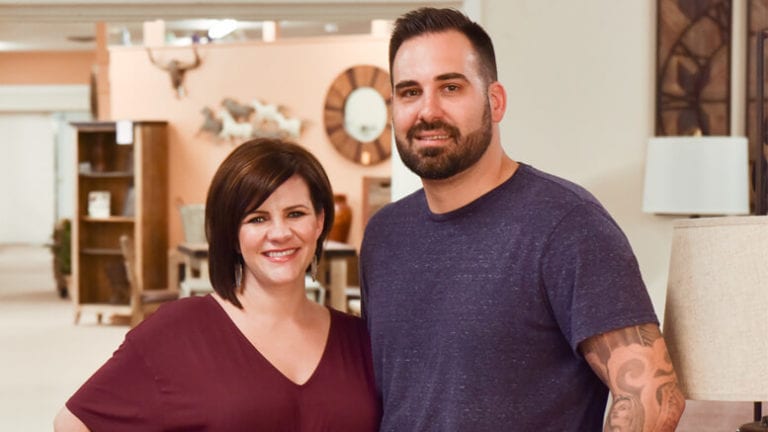And the even better answers behind them
Selling furniture used to be so predictable: Plop down a few hundred bucks for a full-page newspaper ad or 30 seconds on the radio and TV and wait for the parking lot to fill up. Employees made a career out of working at your store, not just a summer. Of course, those days are long gone—if they were even there for you when you started in the business.
Today there’s increasing competition—down the street and on the internet—for shrinking margins. There’s at least a half-dozen mediums to attract consumers, none of which can be ignored. Your staff is starting to show its age just like your store. The mattress you offered white-glove delivery on is now bought online and shipped in a box…on and on the list goes.
As best we know, there’s no dusty book out there with all the answers to questions or problems that come up during your eight-hour (OK, 12-hour) day at the store, but we think we’ve got the next best thing. At the Home Furnishings Association’s Networking Conference in San Antonio this summer, we asked members to share their most nagging questions. Questions that had them stumped them, frustrated them. Questions they were too embarrassed to even ask out loud. Then we promised to go out and find the answers to those questions.
Guess what? We did! Some of those questions are answered on the following pages by experts with more than 200 years of retail experience. That’s a lot of expertise, which is a nice way of saying these folks have been around the block a few times. Take advantage of their experience and knowledge. It’s like free consulting for your store!
Get their email. That’s easier said than done. What’s a fast, easy way to collect a customer’s email address without being too forceful?
Collecting emails and customer participation in giving you their email is a byproduct of what I like to call a “help before you sell” information-first marketing, advertising and sales culture. Here are three ways I collect emails easily in my stores.
On our website, we offer mattress buying guides to educate our customers about their forthcoming purchase, which are delivered via an automated system once the lead has given us their name and email.
When customers visit our store, we sit down in our customer lounge and have in-depth, relaxed conversations about how our sleep systems fit their needs.
Finally, at the point of sale, customers typically will happily and readily offer their email when asked, and you must ask, if up to this point the customer has felt like their interactions with you have been leading to a long-term relationship. You have to change your mindset—a customer’s purpose is not to make a sale, rather a sale is made to create a customer for life.
Jeff Giagnocavo is co-owner of Gardner’s Mattress & More in Lancaster, Pa., and co-founder and co-publisher of Renegade Mattress Retailer Weekly.
We lose a lot of good employees because they don’t see the opportunity to grow here. How can we develop middle management?
The vast majority of furniture stores pay based on productivity. Most of the sales people get commission. In many cases, if you’re a great sales person in a retail store, it doesn’t pay to be a manager because in some cases you can make more money as a sales person than you might be able to as a manager. Sales people become managers because they are compelled to, and anyone who wants to be a manager will be a manager if they do the work.
If you have a company that holds staff highly accountable for production, and they’re paid well, then you’re not going to get much turnover. If a store doesn’t have systems or processes, then that’s where the turnover comes from, because the staff is working in a place where they don’t know how to win.
Harry Friedman is founder and CEO of The Friedman Group, which specializes in retail sales, management and operations.
My mattress store is feeling the pinch from the bed-in-a-box trend. How do I compete?
The first thing is for retailers to accept that mattresses-in-a-box (MIB) are here to stay and lots of shoppers are going to be interested in them. This is neither good nor bad, simply the evolution of the market place in a free society. Second, consider what’s attractive about this new category—it’s simple, relatively inexpensive and it totally cuts out the shopping mission that many people want to avoid.
For the MIB shoppers who do visit your store, it’s likely that many may not even divulge their intentions, they may just be shopping for comparison’s sake. Your first strategy is to discover their intentions. Ask them what they have looked at so far, and if they’ve found anything they’re interested in. Most shoppers will be willing to do that.
Then encourage the shopper to at least see what other products are available, all the while mentioning that comfort is subjective—what one person likes, the next may not. MIB is a one size fits all, the odds of them being a good choice for everyone is unlikely at best.
MIB are a reality and a force to be reckoned with. Smart retailers can rely on the old adage, if you can’t beat them, join them. The paradox? By joining them and offering an MIB program, retailers really can beat them!
Gerry Morris is a former manufacturer’s representative for Serta Mattress Company. He currently travels North America training sales associates and writing for his website sellmorebeds.com.
What are two or three quick and easy projects I could do to give my store a fresh look?
Paint is one of the cheapest things to do for freshening up your store immediately. I suggest you add some vivid strong colors behind all the wood bedrooms and beige upholstery. One more trick is to use the colors of the year presented by all the major paint brands.
The most valuable real estate on your floor is the first 500- to 3,000-square-feet depending on the size of your store. It is the first and last impression of your store brand. Instead of having just a room setting when you enter, create some excitement with a specialized display—for instance six to 12 accent chairs. Or stack accent ottomans, puffs and upholstered benches.
Adding new specialty lighting at the entry and down a main aisle will make a huge statement and also shed some light on where you want to direct your guests. I suggest a stream of six to eight of the same chandelier down an aisle. By selecting a new hip urban look or shiny metal finish, you will automatically be updating your store for the modern world.
Connie Post is a renowned retail design strategist, author, trend translator and developer of both product and brands.
How do I increase traffic and, hopefully, my sales?
That’s the $64,000 question. You may have a tremendous marketing plan, do a great job getting messages out through social media and other vehicles, be in a great location and have a great reputation, but when a customer comes into your store, if you don’t have a properly trained, developed and motivated sales team, it’s all for naught.
Too many retailers don’t have the correct number of sales people, or they don’t hire the correct skill set. You should be looking for enthusiasm, curiosity and caring. Then you have to spend a little time on the management and support of those people. Depending on the level of service a furniture retailer gives, they should average 10 to 15 hours per sales person, per month, in terms of one-on-one focus—observing, coaching, setting goals, measuring the right things.
A big hunk of traffic is repeat business. A properly trained sales manager or coach is going to assist with the follow-up process. If a customer didn’t buy, did the sales person make an attempt to follow up about what the customer was looking for? If the customer did make a purchase, did the sales person follow up to explore additional needs or referrals? All of these things drive traffic.
Joe Milevsky is CEO of JRM Sales & Management, Inc., which helps independent business owners achieve increased sales and profits and the quality of life they desire.
From the minute I get in until the minute I leave, I’m overworked. How do I get more breaks?
I think as store owners, too often we read articles by people who have never been store owners who say this is how life is supposed to be. First you have to decide how much you want to do.
What we will find is a person is doing a whole lot of tasks they should not be—they’re micromanaging. If you go out of town for a conference, you trust your inventory, everything to your staff. But when you come back, do your employees come to you about minor situations? If they were to make those decisions on their own, how much would each decision cost? At a bare minimum $50. If you trust them with all of your inventory, why don’t you trust them to make a $50 decision? If you want to stand around and make $50 decisions, don’t wonder why you’re putting more hours in than you want.
Also, create an owner’s guide, with all the things that have to be done on a regular basis, like changing the air filters. Write down the instructions—filter size, how to put them in, the number of filters in the case, how to re-order—and put it in the notebook every other month. Then delegate it to someone else. It’s as simple as pulling the notebook off the shelf and saying “It’s the first of July, take care of this.”
Small business owner, Tom Shay founded Profits Plus Solutions, Inc. with the aim of helping other small business owners increase their profits, while building their business for the future.
Pricing on our website— should we price everything on our website for the competition to see? What does a consumer think when there’s no price?
Yes—absolutely. Put on your consumer hat, and think of the last thing you purchased, whether it was sunglasses, tickets, a shirt or possibly even furniture. You began your journey online. Whether you made the purchase online or not is irrelevant, you were educated on the web. What would you have done if one of those sites you had gone to didn’t have pricing? The question answers itself.
I gave a presentation years ago, where someone said no to pricing on their website. I asked if they did print with prices, and they said of course. What’s the difference between that and online? People view the web as unnatural, a separate part of the industry that doesn’t belong. But it does, it’s where business starts. Pricing is part of the consumer’s journey—if you’re not putting pricing online, you’re not even giving yourself a shot for engagement with that consumer during the research phase of their decision.
Sure, you can be shopped. Can your competitors find your pricing? Absolutely. But guess what? If they wanted to find out, they would anyway.
Jesse Akre is chief revenue officer for Amber Engine, a team of home furnishing industry innovators, technologists and business experts whose mission is to provide the most accurate, complete and timely record of product data for the home furnishings industry.
I want to convert more website visitors into in- store sales. And I want to track my success, too. Where do I begin?
One thing we do is a study of analytics of what comes from the website, so when a digital campaign or insert is launched, we’re able to see upticks in website visits. Eighty percent of consumers go searching online before they set foot in the store, and we’re able to see that analytic return. We try to focus on creating dynamic landing pages to convert leads and implement special coupons or conversions that you can track, so you know they got that from the website, came to your store and bought something.
You’re still doing an offer, but by pushing consumers to your website to get the free coupon or whatever that conversion tracker is, you get them excited to come into the store and you get their name and information. Now you can track the consumer from the beginning to the end of the purchase.
Just doing direct mail isn’t going to be successful in today’s media world because you’re missing part of your potential customer base. I’m still a believer in inserts. Direct mail works if your market accepts it, but you can’t just throw all your eggs in one basket. Being able to be in as many media as your budget can afford, and in a strategic way, can really create that kind of conversion lead trail. Create that lead, give them something additional, something of value—the customer always wants to say “I saved something today.”
Kevin Doran is CEO/owner of R&A Marketing, experts in traditional media but with a strong focus in digital media that help businesses of all sizes create effective advertising campaigns.
I have a talented but aging sales staff. How do I attract a younger workforce to retail and keep them?
It’s got to be a place they want to work. New stores have no problem getting help because they’re all new, and people are curious. Older stores have their work cut out for them, especially if they’re old and have not been renovated. Younger people need to see people like themselves buying and working there.
The hard thing is that first person. Keeping them requires you to have training. You can’t just pay someone who worked at a competitor and assume they will be able to find their way. They have to shadow someone. Millennials are the smartest, most hopeful generation around, and they get things pretty quickly. If they don’t see a leader, don’t see how their skill set will be improved, they won’t apply, much less stay.
Also, it’s important to work with your existing sales staff on how welcoming they are of people younger than themselves. Are they ageist? Do they look at younger employees with suspicion or as inferiors? Those attitudes will keep people from applying and staying. Finally, don’t be afraid of firing people who are older, just because they’ve worked for you for a while. If they’re not building sales, they should be gone and someone else should be given the opportunity.
Bob Phibbs, CEO of the Retail Doctor, a New York-based consulting firm that helps thousands of businesses in every major industry strengthen their business structure, close more sales, and stay ahead of their competition.
Have a question you want answered? Contact us and we will do our best to feature it in an upcoming blog post.











